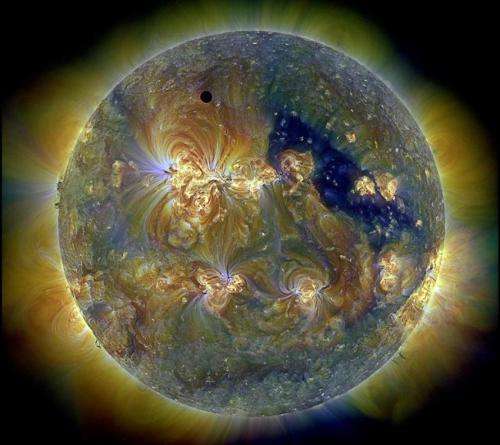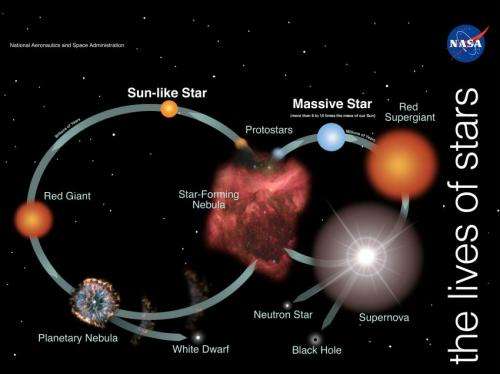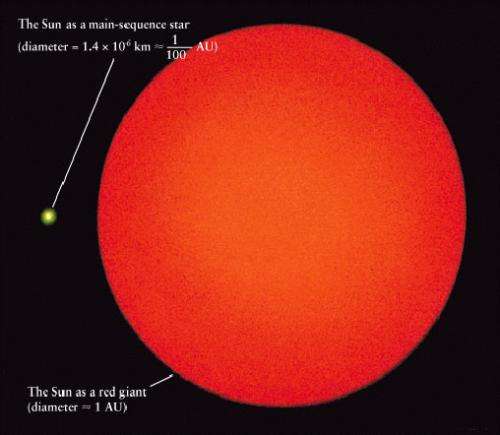Under the bright lights of an aging sun

Life as we know it on Earth is linked to our star, the Sun, which provides our planet with just the right amount of heat and energy for liquid water to be stable in our lakes, rivers and oceans. However, as the Sun ages, it is steadily growing brighter and brighter. Eventually, the sunlight that supports life will become too great, and it will bring an end to habitability on our planet.
A Star is Born and Ages
The Sun formed some 4.5 billion years ago when gravitational attraction caused a massive cloud of gas and dust to collapse. Currently the Sun is stable and has been for billions of years. The bright ball of light in our sky goes about its days generating energy by fusing hydrogen atoms in its core.
As the Sun ages it will enter another stage of stellar evolution where it's atmosphere begins to inflate. This is when the Sun will expand into a red giant star, swallowing planets in the inner Solar System – possibly including the Earth.
As time goes on, the Sun will start shedding its atmosphere and will continue to grow into a massive planetary nebula, which is like a large cloud of gas ejected from the old star. This is a sort of recycling stage, where elements created by the star are sent back to the interstellar medium, thereby providing new materials for more stars to form. Next, the old core of the Sun will cool and collapse into a dense but small hunk of mass known as a white dwarf star. Eventually, it will cool to the point where only a cold, dark husk remains.
Life as we know it is intrinsically tied to the life-cycle of the Sun because we rely on its light for energy. Right now, things are perfect for biology. In the future, this will change dramatically. As the Sun heats up and expands, life on Earth will become increasingly difficult. Long before the Sun becomes a red giant some 4 or 5 billion years from now, our planet will be rendered uninhabitable.
[For educators and the public alike, see the lesson plan, The Lives of Stars]
Dying in a Future Solar System
The fate of the Earth as the Sun grows old is not an old topic. For decades, scientists have studied various scenarios for how an ageing Sun will affect Earth's future habitability. Writers and artists, on the other hand, have explored the idea for centuries.
"I had a dream, which was not all a dream.
The bright sun was extinguish'd, and the stars
Did wander darkling in the eternal space,
Rayless, and pathless, and the icy earth
Swung blind and blackening in the moonless air;"
The opening lines of the poem 'Darkness,' by Lord Byron (1816)
In 1816, Lord Byron wrote the poem Darkness, which is often cited as an early example of a sub-genre of science fiction that tells the tale of a dying Earth. In his vision of Earth's future, the Sun has died and left our planet barren and ice covered, floating in a sea of black and empty space.
In 1935, H. P. Lovecraft and Robert H. Barlow came a little bit closer to what today's scientists believe might happen to the Earth with "Till A'the Seas." In this story, the Sun has expanded to a red giant and humans struggle to survive on an Earth that has been cooked into a barren desert world. However, in real life, humankind will be gone long before a red giant star fills our skies.
Rather than leading us to a rocky ball of ice, an ageing Sun will instead blast the Earth with ever-increasing heat. Before the Sun expands to a red giant, this increased heat will cause dramatic climatic change on our planet.
Discover the latest in science, tech, and space with over 100,000 subscribers who rely on Phys.org for daily insights. Sign up for our free newsletter and get updates on breakthroughs, innovations, and research that matter—daily or weekly.
The Atmosphere in 3-D
Previous models have predicted that an increase of just 6 percent in the solar constant (a measure of incoming solar electromagnetic radiation) would cause a runaway greenhouse effect on Earth that would render the planet uninhabitable as the oceans boil away to space. Based on this number, Earth's habitability could come to an end in around 650 million years from now. However, a more recent study has extended the expected lifetime of Earth as a habitable world.

"One-dimensional models treat the atmosphere as a single vertical column. This single column is meant as a representative average of all points on the Earth," explains Eric Wolf of the Department of Atmospheric and Oceanic Sciences at the University of Colorado Boulder. "While one-dimensional models can treat radiative transfer well (i.e. solar energy and the greenhouse effect), they completely ignore many important aspects such as clouds, dynamics, and the pole to equator gradients of energy which ultimately describe our climate."
Wolf and his colleague Brian Toon, also of UC Boulder, used complex, three-dimensional climate models in order to bring more detail into the picture.
"Three-dimensional models, as we refer to them, are general circulation models of climate. They include a fully, spatially-resolved, rotating planet, with clouds, oceans, sea-ice, weather, etc.," Wolf told Astrobiology Magazine. "The three-dimensional general circulation model I used has also been used for problems of modern climate. General circulation models are considered the most advanced type of climate models."
The added detail of the 3-D models showed that the Earth could remain habitable for longer than previously expected.
"According to my work, the Earth may remain 'habitable' for at least another 1.5 billion years, when the Sun is approximately 15.5 percent brighter than today," said Wolf. "This is the limit of our current study."
It's important to note that a habitable Earth in terms of astrobiology is not necessarily habitable for human beings.
"When we think about exoplanets or the future Earth, scientists refer to a planet as habitable if it has the ability to maintain liquid water at its surface," says Wolf. "However, a planet may maintain liquid water at the surface while still having a climate which is unfriendly to humans."
Today, the mean surface temperature of the Earth is around 58º F. In Wolf's scenario, 1.5 billion years from now, the mean surface temperature of the Earth is estimated to be over 100º F.
"While the oceans remain, life for land animals would be harsh," Wolf told Astrobiology Magazine. "Surviving humans would have to move towards the polar regions to escape the oppressive heat."
Comparing Habitability under a Hot Sun
Theories about the future of habitability on Earth are not simply based on models of the Sun. With astronomical observations, scientists have been able to observe stars in various stages of their life cycles. When discoveries of exoplanets entered the scene, astrobiologists began to hunt for a view of our own future by looking at rocky worlds around such stars. These distant systems can provide points of comparison between the models and real-life observations.
In a study published last year in the scientific journal Astrobiology, a team of researchers from the United Kingdom approached the question of habitability from a different angle. Rather than looking at how a planet evolves over time, they estimated the output of energy from a star as it ages.
"We developed a solar evolution model that extended the scope of a previously published model, from the original 12.6 billion year limit, to over 400 billion years, using updated observations and fits from the Dartmouth Stellar Evolution Database," said lead author Andrew Rushby of the University of East Anglia. "We used limits for the habitable zone that were first presented by Jim Kasting and co-authors in a seminal paper on the subject. These stress the importance of liquid water on the surface of the planet, and assume that the planet we're investigating is a lot like the Earth."
Their simulations identified a point at which increasing radiation from the Sun would render the Earth unable to support liquid water. As with the Wolf et al. study, Rushby and his colleagues (Mark Claire of the University of St Andrews, Hugh Osborn of the University of Warwick, and Andrew J. Watson of the University of Exeter) found a longer lifespan for Earth's habitability, which they estimated to be around 1.75 billion years. They arrived at this number from the vantage point of energy output from the Sun, not by modelling how the climate of the Earth itself is affected.
"It's definitely worth the comparison, but the differences between our approaches should be noted," Rushby said. "We did not take planetary evolution into account. We looked at the star alone and neglected the ability of the planet's carbonate-silicate cycle to potentially buffer the climate against higher temperatures by increased weathering and CO2 drawdown."
In their 'climate' approach, Wolf and his colleagues also used a constant value for carbon dioxide (CO2) and methane (CH4) in their simulations, effectively taking these two elements out of the equation. There are so many factors involved in shaping Earth's climate and how it responds to changes in the Solar System environment that it is necessary to look at a few pieces of the puzzle at a time in order to build a larger picture. With further studies, the goal will be to include more factors like carbon dioxide and methane to the mix to gradually increase the accuracy of the models.

Comparative planetology works both ways, and studying the future of Earth can also help astronomers find exoplanets that might fit the habitability bill themselves. Rushby and colleagues studied our solar system with a model that was developed to study habitability around other stars. This is the focus of their wider research goals.
"My primary interest was other habitable planets; how long would these other worlds be temperate for?" said Rushby. "In some cases (planets around small red dwarfs), we predict over 40 billion years. We wanted to be able to help astronomers in identifying planets that could host advanced life, or at least life that could leave clues in the atmosphere, and there's no point in looking at planets that haven't been able to support life for very long because life takes billions of years to develop and evolve."
Coming from the angle of Earth's climate, the study by Wolf and colleagues also has wider implications.
"Scientists today use climate models of various types (1D and 3D) to examine the runaway glaciation and runaway greenhouse thresholds for Earth, and then we can apply these concepts to our observations of extrasolar planets," said Wolf.
The Earth orbits around the Sun in a region known as the 'habitable zone,' where the energy from the Sun is just right for liquid water to remain stable at the planet's surface. Life as we know it requires water to survive, so identifying the 'habitable zone' around distant stars is the first step in the hunt for Earth-like worlds.
"As of today, Earth is the only planet that we know for sure has had a habitable period," said Wolf. "Water-based life is also all that we know, so all ideas regarding habitable exoplanets (or early Mars for example) revolve around the presence of water. Thus, our studies of the habitable zones for extrasolar planets virtually all start with a water-rich, Earth-analog planet."
When a planet sits too close to a star, the energy can cause a runaway greenhouse similar to what we see today on Venus. If the planet is too far away, it becomes so cold that water is only stable as solid ice.
As a star ages and expands, the habitable zone also moves further outward in a solar system. Eventually, this zone is pushed out beyond the orbits of inner planets that were once happily orbiting inside of it. By using models developed for Earth, Wolf and Toon have shown that this process of a shifting habitable zone around a star is actually delayed.
"Earth-sized extrasolar planets can maintain habitability despite receiving relatively larger amounts of solar radiation than was previously thought," Wolf said. "This pushes the inner-edge of the habitable zone to be a little closer to the parent star. Our work provides a sort of updated guideline to the inner-edge of the habitable zone that can be used by observational astronomers."
Cooking the Climate
The two studies combined highlight the increasing crossover between earth sciences and the search for extrasolar planets. Tools developed to study our home planet can now be adapted to study planets in other systems, and vice versa.
"I definitely see the potential for crossover between exoplanet science and climate science here on Earth," said Rushby. "After all, researchers in both fields are looking for answers to a similar question: what is the climate of this planet like? Can we predict how the climate of this world is going to respond to a forcing, whether it be from human sources, volcanism, weathering, increased solar irradiation etc. In fact, the crossover is already happening."
The studies provide new insight into the distant future of Earth and that of planets millions of light years away. However, it also ties in to modern climate issues closer to home. The models used to study circulation of the Earth's climate are also some of the most prominent ones employed in the study of current climate change on our planet. While Wolf and Toon's work shows that Earth can maintain habitability long after the Sun has caused the planet to heat up, it's important to remember that this potential for life is based on liquid water and does not include humankind.
"Modern CO2 climate change is unlikely to trigger a runaway greenhouse catastrophe," said Wolf. "However, this does not imply that there is no danger due to anthropogenic [human induced] climate change. A human catastrophe can be caused by only a few degree temperature increase accompanied with sea level rise."
Journal information: Astrobiology
Source: Astrobio.net
This story is republished courtesy of NASA's Astrobiology Magazine. Explore the Earth and beyond at www.astrobio.net .





















